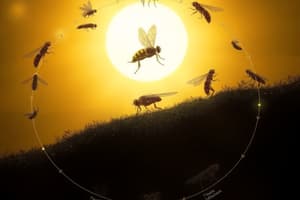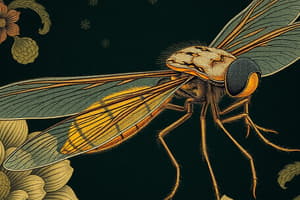Podcast
Questions and Answers
What transformation occurs in the tsetse fly after the parasites leave the midgut?
What transformation occurs in the tsetse fly after the parasites leave the midgut?
- The parasites become procyclic trypomastigotes.
- The parasites become epimastigotes. (correct)
- The parasites become metacyclic trypomastigotes.
- The parasites become bloodstream trypomastigotes.
Which type of locomotion is exhibited by Amoeba?
Which type of locomotion is exhibited by Amoeba?
- Ciliary movement
- Flagellar movement
- Gliding movement
- Amoeboid movement (correct)
What is the primary reservoir for Trypanosoma brucei gambiense?
What is the primary reservoir for Trypanosoma brucei gambiense?
- Wild game animals
- Humans (correct)
- Rodents
- Birds
How do parasitic amoebae regulate water within their environment?
How do parasitic amoebae regulate water within their environment?
Which of the following is an example of a parasitic amoeba?
Which of the following is an example of a parasitic amoeba?
What distinguishes Entamoeba histolytica from Entamoeba coli in terms of habitat?
What distinguishes Entamoeba histolytica from Entamoeba coli in terms of habitat?
Which feature is NOT associated with the trophozoite of Entamoeba coli?
Which feature is NOT associated with the trophozoite of Entamoeba coli?
What is the characteristic of the cyst of Entamoeba histolytica?
What is the characteristic of the cyst of Entamoeba histolytica?
Which of the following is a feature of the Apicomplexa class that differentiates it from other protozoan parasites?
Which of the following is a feature of the Apicomplexa class that differentiates it from other protozoan parasites?
Why is Entamoeba histolytica considered a harmful endoparasite?
Why is Entamoeba histolytica considered a harmful endoparasite?
Flashcards
Entamoeba histolytica
Entamoeba histolytica
A parasitic amoeba that causes amoebic dysentery by feeding on host tissues and blood.
Entamoeba coli
Entamoeba coli
A commensal amoeba that lives in the large intestine, feeding on bacteria, and is harmless.
Trophozoite stage
Trophozoite stage
The feeding stage of an amoeba; it is characterized by active movement and feeding.
Cyst
Cyst
Signup and view all the flashcards
Apicomplexa Parasite
Apicomplexa Parasite
Signup and view all the flashcards
African Trypanosomes Life Cycle
African Trypanosomes Life Cycle
Signup and view all the flashcards
Trypanosome Transmission
Trypanosome Transmission
Signup and view all the flashcards
Amoeba Locomotion
Amoeba Locomotion
Signup and view all the flashcards
Amoeba Feeding
Amoeba Feeding
Signup and view all the flashcards
Parasitic Amoebae Types
Parasitic Amoebae Types
Signup and view all the flashcards
Study Notes
Tsetse Fly and Trypanosomes
- Tsetse flies transmit trypanosomes, a type of parasite.
- The parasites infect mammals.
- The life cycle involves metacyclic trypomastigotes injected into the mammalian host.
- These transform into bloodstream trypomastigotes, carried to other sites (lymph, spinal fluid).
- Replication occurs by binary fission.
- The parasite infects the tsetse fly by taking a blood meal.
- In the fly's midgut, parasites become procyclic trypomastigotes, multiply, and transform into epimastigotes.
- Epimastigotes multiply in the fly's salivary glands.
- The cycle in the fly takes about 3 weeks.
- Humans are the main reservoir for Trypanosoma brucei gambiense, though wild game animals are the primary reservoir for T. b. rhodesiense.
Sarcodina (Amoebozoa)
- Sarcodina are protozoans with a protoplasmic membrane and no defined shape.
- Pseudopodia are used for locomotion and feeding.
- They can be free-living (like Amoeba), commensal (Entamoeba coli), or parasitic (Entamoeba histolytica).
Amoeba proteus
- Amoeba proteus lives in well-oxygenated fresh water.
- It's found on decaying vegetation in pools, ponds, and streams.
- Water regulation occurs via contractile vacuoles.
- Amoeba moves and feeds using pseudopodia.
- Its movement is known as amoeboid movement.
- It involves changes in the protoplasm (from a sol state to a gel state).
Feeding in Amoeba
- Bacteria are engulfed by pseudopodia.
- This creates a food vacuole (phagosome).
- The food vacuole fuses with lysosomes, forming a phagolysosome.
- Digestion occurs within the phagolysosome, and nutrients absorbed.
- Waste products are expelled from the cell.
Parasitic Amoebae (Class Archamoeba)
- Six genera of parasitic amoebae are known, five are in the intestinal tract, one in the buccal cavity.
- Entamoeba coli is a commensal found in the intestines.
- Entamoeba histolytica causes amoebic dysentery; a parasitic amoeba in the intestines.
- Entamoeba gingivalis is a commensal found in the buccal cavity.
Comparison between Entamoeba histolytica and E. coli
| Feature | Entamoeba histolytica | Entamoeba coli |
|---|---|---|
| Habitat | Lives in the wall of the large intestine. Dangerous endoparasite feeding on tissues and blood; causing dysentery. | Lives in the lumen of the large intestine; commensal, feeding on bacteria |
| Pseudopodia | Single, large pseudopodium | Two pseudopodia |
| Karyosome | Central | Lateral |
| Chromatin | Regularly distributed | Irregularly distributed |
| Food Vacuoles | Contains RBCs | Contains bacteria |
| Cyst | Vacuoles with glycogen; mature cyst with 4 nuclei | Vacuoles lacking glycogen; mature cyst with 8 nuclei. |
Plasmodium (Phylum Apicomplexa)
- Plasmodium is an intracellular parasite.
- It causes malaria in humans and other mammals.
- Transmitted by bloodsucking arthropods (intermediate hosts).
- Four species cause malaria: P. vivax, P. malariae, P. ovale, P. falciparum.
- Malaria is caused by parasites of Plasmodium.
Plasmodium Life Cycle
- The life cycle involves an erythrocytic cycle in the liver and blood, and a mosquito cycle (sexual reproduction).
- Gametocytes are sexual stages in the host
- The exerythrocytic cycle occurs in the liver.
- The erythrocytic cycle occurs in human red blood cells.
- A mosquito bite releases sporozoites into the bloodstream for the next cycle.
Studying That Suits You
Use AI to generate personalized quizzes and flashcards to suit your learning preferences.




